In an increasingly digital world, security camera have become essential for protecting homes and businesses. With various types, features, and technologies available, choosing the right security camera can be overwhelming. This comprehensive guide will help you understand what to consider when selecting a security camera, ensuring you make an informed decision that meets your specific security needs.
1. Understand Your Security Needs
Before diving into the types of cameras available, it’s crucial to assess your security needs. Consider the following questions:
- What areas do you need to monitor? Identify key locations that require surveillance, such as entry points, driveways, backyards, or business premises.
- What type of threats are you most concerned about? Different environments pose various risks, such as burglary, vandalism, or employee theft.
- Are you looking for indoor or outdoor cameras? Outdoor cameras need to withstand the elements, while indoor cameras can focus more on aesthetics and specific monitoring needs.
Understanding your security requirements will help narrow down your options and ensure you choose the right camera for your situation.
2. Types of Security Cameras
There are several types of security cameras available, each designed for specific purposes. Here are some of the most common types:
2.1 Dome Cameras
Dome cameras are named for their dome-shaped housing, making them less conspicuous and more aesthetically pleasing. They are typically used indoors but can be designed for outdoor use as well. Dome cameras are known for their durability and can be resistant to tampering, making them a popular choice for businesses.
2.2 Bullet Cameras
Bullet cameras have a cylindrical shape and are generally more noticeable than dome cameras. They are ideal for outdoor surveillance, as they often come with features like weatherproof housing and infrared night vision. Bullet cameras are suitable for monitoring long distances, making them excellent for parking lots and building perimeters.
2.3 PTZ Cameras
PTZ (Pan-Tilt-Zoom) cameras are advanced devices that can be remotely controlled to pan, tilt, and zoom in on specific areas. This versatility allows you to monitor larger spaces effectively. PTZ cameras are excellent for surveillance in large areas, such as parking lots, stadiums, and public spaces.
2.4 Wireless Cameras
Wireless security cameras use Wi-Fi to transmit data, eliminating the need for extensive wiring. These cameras are easy to install and can be relocated easily. However, it’s essential to ensure that your Wi-Fi signal is strong in the areas you intend to monitor.
2.5 Smart Cameras
Smart cameras integrate with smart home systems, allowing for remote access and control via smartphones or tablets. These cameras often come with additional features such as motion detection, two-way audio, and cloud storage. Smart cameras can enhance the functionality of your home security system significantly.
3. Key Features to Consider
When selecting a security camera, consider the following features that can enhance your security setup:
3.1 Resolution
The resolution of a security camera determines the clarity and detail of the footage. Higher resolution cameras provide clearer images, making it easier to identify faces or license plates. Look for cameras with at least 1080p (Full HD) resolution for optimal clarity.
3.2 Night Vision
Night vision is crucial for effective surveillance in low-light conditions. Infrared night vision allows cameras to capture clear footage in complete darkness. Some cameras also offer color night vision, providing better detail in low-light scenarios.
3.3 Motion Detection
Motion detection allows security cameras to alert you when movement is detected. This feature can help you respond quickly to potential threats. Look for cameras that offer customizable sensitivity settings, so you can reduce false alarms from pets or passing vehicles.
3.4 Storage Options
Security cameras typically store footage either locally (on an SD card or hard drive) or in the cloud. Local storage can be more cost-effective, while cloud storage offers the convenience of remote access and protection from theft or damage. Consider your storage needs and budget when choosing a camera.
3.5 Two-Way Audio
Cameras equipped with two-way audio allow you to listen and communicate through the camera. This feature is beneficial for monitoring visitors at your doorstep or communicating with employees in a business setting.
4. Installation Considerations
Proper installation is critical to the effectiveness of your security camera system. Consider the following tips:
4.1 Placement
Choose strategic locations for your cameras to maximize coverage. Ensure cameras are positioned to capture key areas without obstructions. High-traffic areas, entry points, and blind spots should be prioritized.
4.2 Power Supply
Ensure that your cameras are powered correctly. Wireless cameras require a strong Wi-Fi signal, while wired cameras may need proximity to power outlets. Consider using Power over Ethernet (PoE) cameras for easier installation and power management.
4.3 Professional vs. DIY Installation
Decide whether you want to install the cameras yourself or hire a professional. While DIY installation can save money, professionals ensure that cameras are placed optimally and configured correctly.
5. Budgeting for Your Security Camera System
When selecting a security camera, consider your budget. While it’s essential to invest in quality cameras, there are options available for various price points. Keep the following in mind:
- Initial Cost: This includes the price of the cameras, installation (if applicable), and any additional equipment, such as storage solutions.
- Ongoing Costs: Factor in potential subscription fees for cloud storage or additional features that may require monthly payments.
6. The Role of Technology in Security Cameras
As technology evolves, security cameras are becoming more advanced. Stay informed about the latest developments in security camera technology to choose a system that meets your future needs.
6.1 Artificial Intelligence and Analytics
AI-powered cameras can analyze footage in real-time, distinguishing between normal and suspicious activity. This technology reduces false alarms and enhances monitoring efficiency.
6.2 Integration with Other Systems
Modern security cameras can integrate with alarm systems, smart locks, and other security features, creating a comprehensive security solution. Look for systems that offer seamless integration options.
Conclusion
Choosing the right security camera for your home or business is a crucial decision that requires careful consideration. By understanding your security needs, exploring the various types of cameras, and evaluating essential features, you can select a camera system that best fits your requirements. With the advancements in technology and the importance of securing your property, investing in a quality security camera system is more critical than ever. Ensure that your property remains safe and secure, giving you peace of mind in an unpredictable world.












